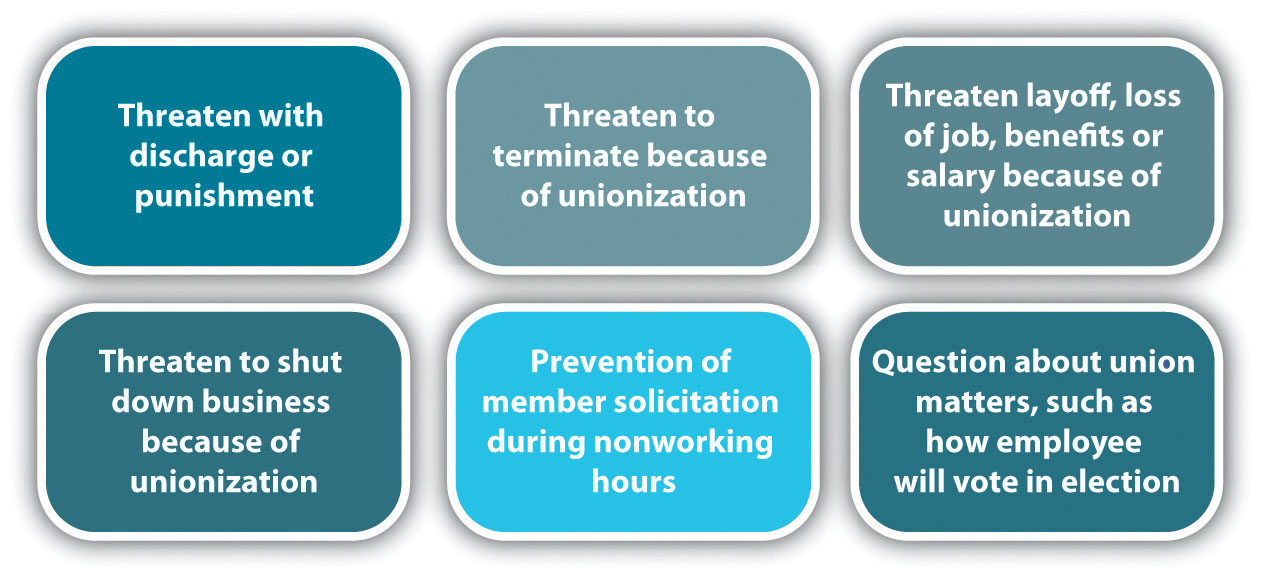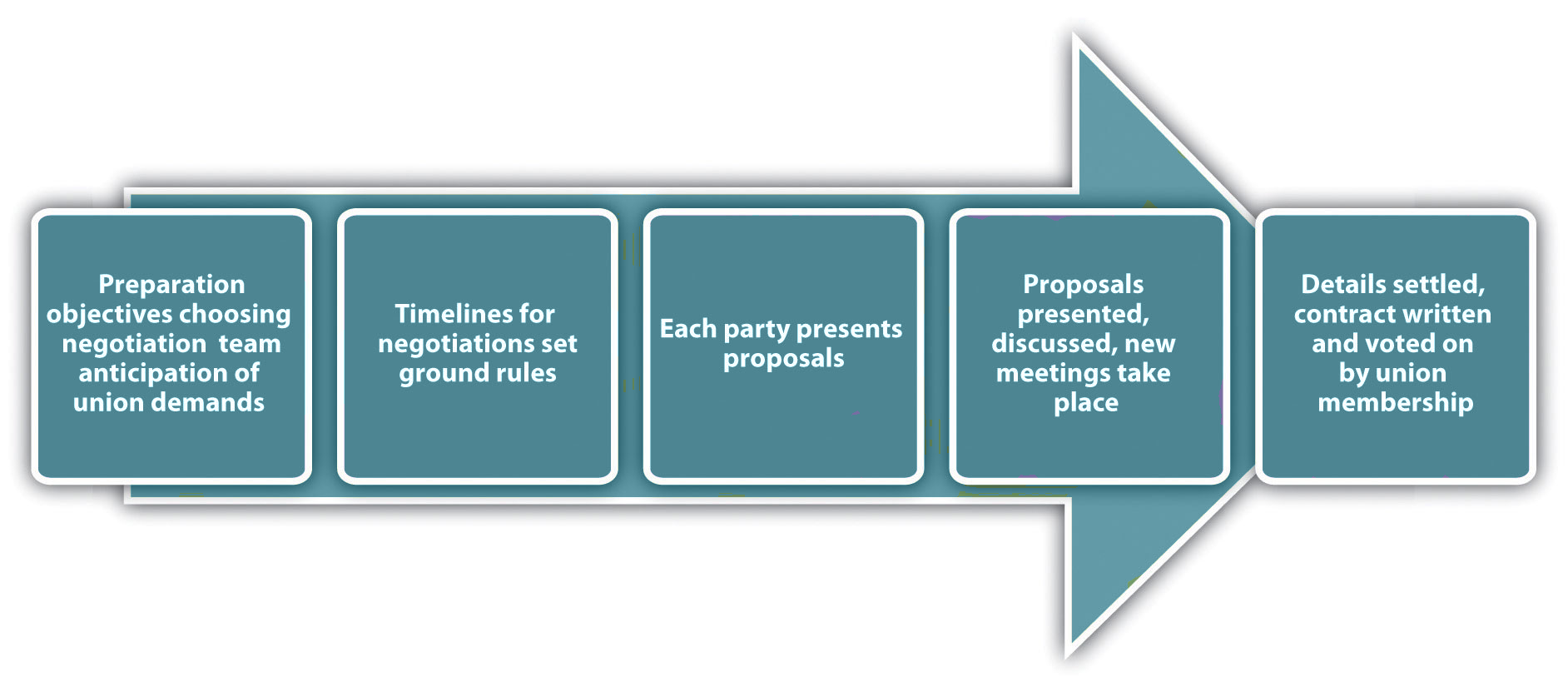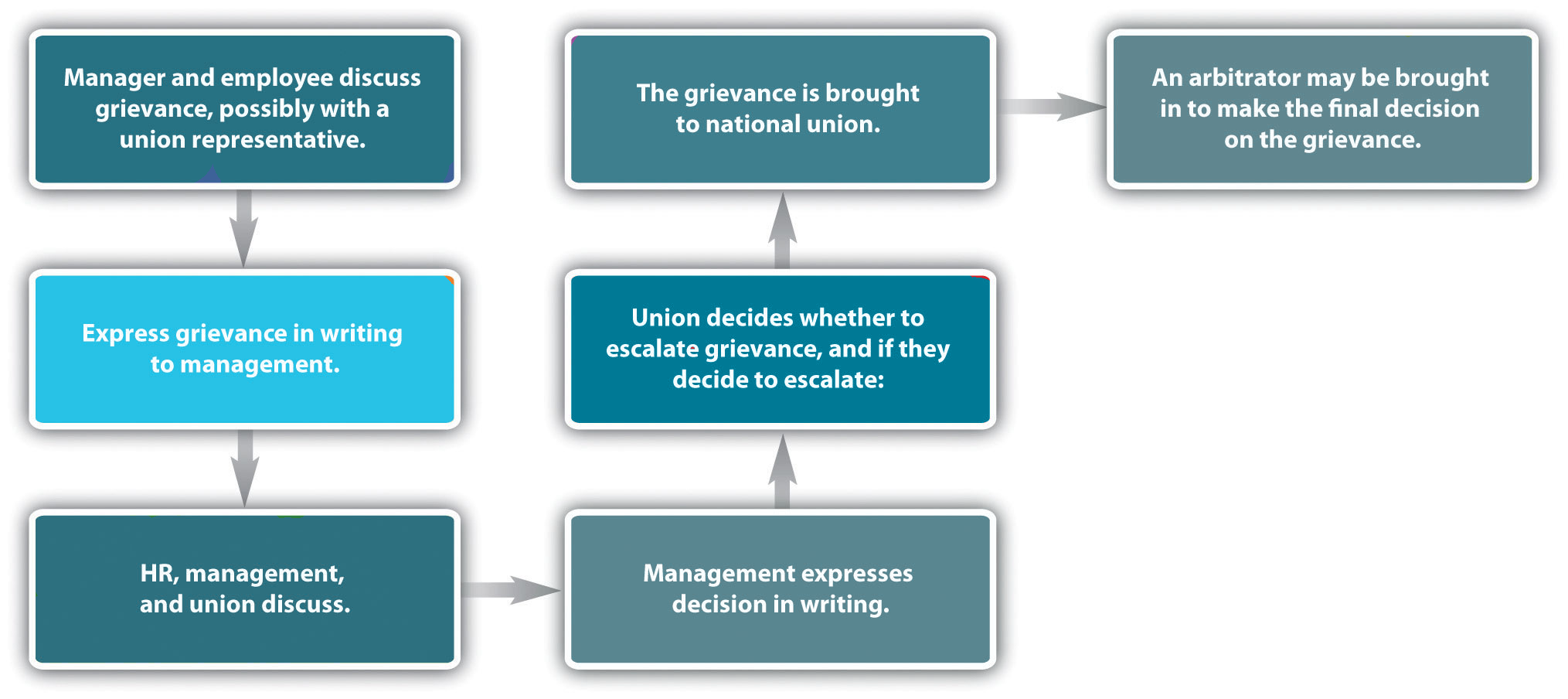2.5 Labour Relations
In this section:
Unions in Canada: A Brief History
At some time in your career in Canada, you may encounter labour relations/negotiations in a unionized work environment. According to Statistics Canada (2022), 30.9% of employees in the Canadian workforce are unionized employees. Rates of unionized workplaces vary by industry and also by geographical region (StatCan, 2021). The purpose of this section is to give students some background about unions and negotiations within a unionized work environment.
Let’s discuss some basic information about unions before we discuss the unionization process.
Trade unions were developed in Europe during the Industrial Revolution, when employees had little skill and thus the entirety of power was shifted to the employer. When this power shifted, many employees were treated unfairly and underpaid. In the United States, unionization increased with the building of railroads in the late 1860s. Wages in the railroad industry were low and the threat of injury or death was high, as was the case in many manufacturing facilities with little or no safety laws and regulations in place. As a result, the Bortherhood of Locomotive Engineers and several other brotherhoods (focused on specific tasks only, such as conductors and brakemen) were formed to protect workers’ rights, although many workers were fired because of their membership.
Craft unions first arose in Canada in the 1820s; these are made up of a specific trade or skilled workers (e.g. printers, shoemakers, masons, bakers and tailors). The first union action in Canada occurred when the Toronto Typographical Union went out on strike in 1872 when its demands for standardized shorter working days were ignored. The rapid industrialization associated with the first World War, led to a rapid growth of the labour movement in the country. The failure and violence of the Winnipeg General Strike (1919) combined with the Depression of the 1930s hurt Canadian unionization until World War II. The post-war era saw union membership soar to 4 million members in the 1990’s. Part of this growth is related to the unionization of government employees that grew rapidly from 1965 to the present. Today, Canada has a relatively high unionization rate.
Union Structure
Unions have a pyramidal structure much like that of large corporations. At the bottom are locals that serve workers in a particular geographical area. Certain members are designated as stewards to serve as go-betweens in disputes between workers and supervisors. Locals are usually organized into national or regional unions that assist with local contract negotiations, organize new locals, help negotiate contracts, and lobby government bodies on issues of importance to organized labour. In turn, national or regional unions may be linked by a labour federation which provides assistance to member unions and serves as a principal political organ for organized labour. Here are the basic units that compose unions:
- Local represents workers in their own workplace or town (e.g., Quebec Crane Operator, Local 791G)
- Parent union decides on union policy for all locals across the province, country or world (e.g., CSN, FTQ)
- National unions represent union members across the country (e.g., PSA, Unifor).
- International unions represent union members in more than one country (e.g., UAW, Teamsters).
- Central labour organizations do not negotiate union contracts but lobby government to pass laws favourable to unions (e.g., Canadian Labour Congress).
Working with Labour Unions as Management
First and foremost, when working with labour unions, a clear understanding of the contract is imperative for all managers. The contract (also called the collective bargaining agreement) is the guiding document for all decisions relating to employees. All human resources (HR) professionals and managers should have intimate knowledge of the document and be aware of the components of the contract that can affect dealings with employees. The agreement outlines all requirements of managers and usually outlines how discipline, promotion, and transfers will work.
Because as managers we will be working with members of the union on a daily basis, a positive relationship can not only assist the day-to-day operations but also create an easier bargaining process. Solicitation of input from the union before decisions are made can be one step to creating this positive relationship. Transparent communication is another way to achieve this goal.
Legislation and Unionization
The path to unionization and the process of maintaining a union is heavily regulated. These regulations can greatly vary from one legislation to another. In Canada, the system of collective bargaining is embodied in federal and provincial labour relations acts and labour codes. Canadian workers have the right to join trade unions, which may be certified to collectively bargain conditions of employment with their employers on their behalf. The Federal Public Service Labour Relations Act (PSLRA) is the law that regulates the collective bargaining and grievance adjudication systems in the federal public service. Provincial legislation, such as the Labour Relations Code in British Columbia, the Labour Act of Prince Edward Island, and the Quebec Labour Code, regulate various aspects of labour relations for most workplaces.
The creation of a union follows has to follow a fairly strict process which is outlined in the table below.
The Unionization Process
Table 2.9 The Unionization Process
| Union and employees make contact | As a result of employee dissatisfaction, union and employees make contact and discuss possibility of joining forces. |
| Initial Organization Meeting | Initial meeting with union is scheduled to gather employee support. |
| Formation of organizing committee | Local union leadership is identified. Its objectives is to organize a campaign to obtain the signature of a majority of workers willing to join the union. |
| Application to Labour Relations Board | Once a majority of these signatures are gathered, the workers can apply for official recognition to the Labour Relation Board. |
| Certificate is issues by the Board | After checking the process and the signatures, the Board certifies the union. |
| Election of bargaining committee and contract negotiation | After having been certified, the first step for the newly formed union is to elect a bargaining team that will be tasked with negotiating a contract with the employer. |
| Source: Human Resources Management – Canadian Edition | |
It is advisable for HR and management to be educated on what can legally and illegally be said during this process. It is illegal to threaten or intimidate employees if they are discussing a union. Employers cannot threaten job, pay, or benefits loss as a result of forming a union.

Collective Bargaining
When employees of an organization vote to unionize, the process for collective bargaining begins. Collective bargaining is the process of negotiations between the company and representatives of the union. The goal is for management and the union to reach a contract agreement, which is put into place for a specified period of time. Once this time is up, a new contract is negotiated. In this section, we will discuss the components of the collective bargaining agreement.
In any bargaining agreement, certain management rights are not negotiable, including the right to manage and operate the business, hire, promote, or discharge employees. However, in the negotiated agreement there may be a process outlined by the union for how these processes should work. Management rights also include the ability of the organization to direct the work of the employees and to establish operational policies.
Another important point in the collective bargaining process is the aspect of union security. Obviously, it is in the union’s best interest to collect dues from members and recruit as many new members as possible. In the contract, a checkoff provision may be negotiated. This provision occurs when the employer, on behalf of the union, automatically deducts dues from union members’ paychecks. This ensures that a steady stream of dues is paid to the union.
In a collective bargaining process, both parties are legally bound to bargain in good faith. This means they have a mutual obligation to participate actively in the deliberations and indicate a desire to find a basis for agreement. There are three main classification of bargaining topics: mandatory, permissive, and illegal. Wages, health and safety, management rights, work conditions, and benefits fall into the mandatory topics category. Permissive topics are those that are not required but may be brought up during the process. An example might include the requirement of drug testing for candidates or the required tools that must be provided to the employee to perform the job, such as a cellular phone or computer. It is important to note that while management is not required by labour laws to bargain on these issues, refusing to do so could affect employee morale. We can also classify bargaining issues as illegal topics, which obviously cannot be discussed. These types of illegal issues may be of a discriminatory nature or anything that would be considered illegal outside the agreement.
Some examples of bargaining topics include:
- Pay rate and structure
- Health benefits
- Incentive programs
- Job classification
- Performance assessment procedure
- Vacation time and sick leave
- Health plans
- Layoff procedures
- Seniority
- Training process
- Severance pay
- Tools provided to employees
- Process for new applicants
The Collective Bargaining Process
The collective bargaining process has five main steps; we will discuss each of these steps in turn.

Steps in Collective Bargaining
The first step is the preparation of both parties. The negotiation team should consist of individuals with knowledge of the organization and the skills to be an effective negotiator. An understanding of the working conditions and dissatisfaction with working conditions is an important part of this preparation step. Establishing objectives for the negotiation and reviewing the old contract are key components to this step. Both sides should also prepare and anticipate demands, to better prepare for compromises.
The second step of the process involves both parties agreeing on how the timelines will be set for the negotiations. In addition, setting ground rules for how the negotiation will occur is an important step, as it lays the foundation for the work to come.
In the third step, each party comes to the table with proposals. It will likely involve initial opening statements and options that exist to resolve any situations that exist. The key to a successful proposal is to come to the table with a “let’s make this work” attitude. An initial discussion is had and then each party generally goes back to determine which requests it can honor and which it can’t. At this point, another meeting is generally set up to continue further discussion.
Once the group comes to an agreement or settlement (which may take many months and proposals), a new contract is written and the union members vote on whether to accept the agreement. If the union doesn’t agree, then the process begins all over again.
Ramifications of a Bargaining Impasse
When the two parties are unable to reach consensus on the collective bargaining agreement, this is called a bargaining impasse. Various kinds of strikes are used to show the displeasure of workers regarding a bargaining impasse. An economic strike is a strike stemming from unhappiness about the economic conditions during contract negotiations. An unfair labour practices strike can happen during negotiations. The goal of an unfair labour practice strike is to get the organization to cease committing what the union believes to be an unfair labour practice. A bargaining impasse could mean the union goes on strike or a lockout occurs. The goal of a lockout, which prevents workers from working, is to put pressure on the union to accept the contract. A lockout can only be legally conducted when the existing collective bargaining agreement has expired and there is truly an impasse in contract negotiations.
Similarly, the goal of a strike is to put pressure on the organization to accept the proposed contract. Some organizations will impose a lockout if workers engage in slowdowns, an intentional reduction in productivity. Some unions will engage in a slowdown instead of a strike, because the workers still earn pay, while in a strike they do not. A sick-out is when members of a union call in sick, which may be illegal since they are using allotted time, while a walk-out is an unannounced refusal to perform work. However, this type of tactic may be illegal if the conduct is irresponsible or indefensible, according to a judge. Jurisdictional strikes are used to put pressure on an employer to assign work to members of one union versus another (if there are two unions within the same organization) or to put pressure on management to recognize one union representation when it currently recognizes another. The goal of a sick-out strike is to show the organization how unproductive the company would be if the workers did go on strike. Sympathy strikes are work stoppages by other unions designed to show support for the union on strike. While they are not illegal, they may violate the terms of the collective bargaining agreement.
The Grievance Process
A violation of the contract terms or perception of violation normally results in a grievance. A grievance procedure or process is normally created within the collective bargaining agreement. The grievance procedure outlines the process by which grievances over contract violations will be handled. As you have probably already identified, the grievance procedure is a formalized conflict. Learning how to handle this type of conflict takes self-management skills—or the ability to avoid taking things personally—and relationship management skills.
Most grievances fall within one of four categories. There are individual or personal grievances, in which one member of the union feels he or she has been mistreated. A group grievance occurs if several union members have been mistreated in the same way. A principle grievance deals with basic contract issues surrounding seniority or pay, for example. If an employee or group is not willing to formally file a grievance, the union may file a union or policy grievance on behalf of that individual or group.
The important things to remember about a grievance are that it should not be taken personally and, if used correctly, can be a fair, clear process to solving problems within the organization.
Procedures for Grievances
The grievance procedure is specific to each contract, so we will discuss the process in generalities. A grievance is normally initiated by an employee and then handled by union representatives. Most contracts specify how the grievance is to be initiated, the steps to complete the procedure, and identification of representatives from both sides who will hear the grievance. Normally, the human relations department is involved in most steps of this process. The basic process is shown in Figure 2.9.

Conflict in these situations can result in major issues on both sides, such as grievances and strikes. Employing effective communication skills can reduce conflict and raise productivity in a union environment. The first step is normally an informal conversation with the manager, employee, and possibly a union representative. Many grievances never go further than this step, because often the complaint is a result of a misunderstanding. If the complaint is unresolved at this point, the union will normally initiate the grievance process by formally expressing it in writing. At this time, HR and management may discuss the grievance with a union representative. If the result is unsatisfactory to both parties, the complaint may be brought to the company’s union grievance committee. This can be in the form of an informal meeting or a more formal hearing.After discussion, management will then submit a formalized response to the grievance. It may decide to remedy the grievance or may outline why the complaint does not violate the contract. At this point, the process is escalated.Further discussion will likely occur, and if management and the union cannot come to an agreement, the dispute will normally be brought to a national union officer, who will work with management to try and resolve the issue. A mediator may be called in, who acts as an impartial third party and tries to resolve the issue.
If no resolution develops, an arbitrator might be asked to review the evidence and make a binding decision in the situation. Thus, arbitration is the final aspect of a grievance.
Some examples of grievances might include the following:
- One employee was promoted over another, even though he had seniority.
- An employee doesn’t have the tools needed to perform his or her job, as outlined in the contract.
- An employee was terminated, although the termination violated the rules of the contract.
- An employee was improperly trained on chemical handling in a department.
Adapted Works
“Working with Labor Unions” in Human Relations by Saylor Academy is licensed under a Creative Commons Attribution-NonCommercial-ShareAlike 3.0 Unported License without attribution as requested by the work’s original creator or licensor.
“Unionization Process” in Human Resources Management – Canadian Edition by Stéphane Brutus and Nora Baronian is licensed under a Creative Commons Attribution-NonCommercial-ShareAlike 4.0 International License, except where otherwise noted.
References
StatCan. (2021, January 10). Union coverage rate in Canada in 2020, by province [Graph]. In Statista. https://www.statista.com/statistics/442980/canada-union-coverage-rate-by-province/
Statistics Canada. (2022). Union status by industry (Table 14-10-0132-01). https://doi.org/10.25318/1410013201-eng

